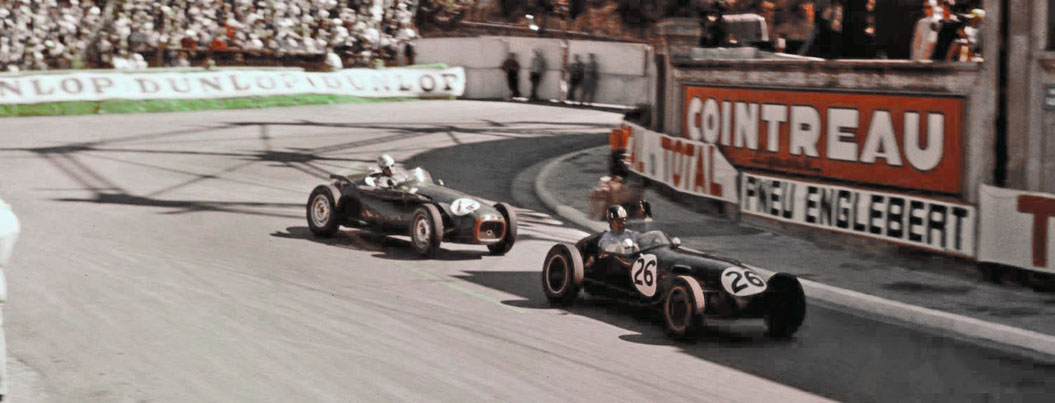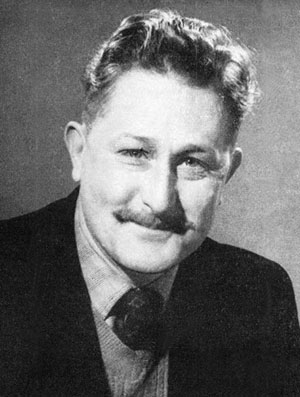Paul Emery (12 November 1916 – 3 February 1993) was a racing driver from England.
Emery was born in Chiswick, London. He built a number of front wheel drive 500cc Formula 3 cars named Emeryson and drove them himself. He participated in two World Championship Formula One Grands Prix, debuting on 14 July 1956 and numerous non-Championship Formula One races. He scored no championship points.
Emery died in Epsom, Surrey, aged 78. Info from Wiki
Bio by Stephen Latham
Apologies if some of the information (regarding cars, and the models /years produced) are out of sequence as there were a lot of different articles on the Emeryson cars.
An innovative designer and engineer, many of Paul Emery’s ideas were ahead of their time but lack of resources meant that they were never properly realised. Of his cars, he stated “I built my own cars because I wanted to race and never had enough money to go racing except by building my own cars.”
Born in 1916, his father George had a garage, where part of the business was preparing competition cars and Paul worked as an apprentice. However, when relations between him and his father became fractious he would go to work for Geoffrey Taylor at Alta.
After the war they built a prototype single-seater, titled an Emeryson, which was fitted with a 1934 Lagonda Rapier engine, reduced in capacity and had two stage supercharging. Working from a shed, they produced a car which proved fast and good enough to win first time out, when Eric Winterbottom won with it in 1947 at Gransden Lodge’s airfield circuit. While building it, they ran out of money before the car had a body fitted and they didn’t even have enough to pay to the entry fee for the Gransden Lodge race. Eric Winterbottom had run an 1100 cc Alta, prepared by George Emery, before the war so a deal was arranged where he would pay the fee for two races and drive the car in the first, with Paul racing in the second. Even without bodywork, it was timed at 136 mph and Eric won his handicap race convincingly. Frustratingly, despite building the car, Paul could not afford to run it and it was driven for the rest of 1947 by other drivers. He did race an Emeryson at Silverstone, finishing second in class and was second in the Burghfield Common Speed Trials with a Hudson Special.
He began to consider a design for F3 in the early part of 1949 but it was 12 months before the first car emerged. As F3 grew in popularity, so it became more professional and he stated ”I couldn’t afford the prices asked for an engine capable of winning…and so I packed it in.” The company had sold a number of customer cars and one was later converted for F2; fitted with an Aston Martin engine it ran in several Formula 1 races, including Colin Chapman in 1954’s International Trophy. The car’s Aston Martin engine was reduced to 2 litres and featured a complex system for lowering the prop shaft and the driver’s seating position.
During this period he took second in class with the Hudson at Great Auclum Speed Trials in 1949 and in 1950 raced the Emeryson JAP to second at Brands Hatch plus contested the Jersey Road Race. In F3 in 1951, he was third at Brands in a Norton powered Emeryson while his best result the following year was a third at Snetterton. He travelled with his F3 car to Picardy, finishing second, while in the UK his best results were sixth at Goodwood and at Brands Hatch’s Daily Telegraph Trophy plus took fourth place at Snetterton with an F2 Emeryson Alta.
After the Aston Martin unit had been replaced by an Alta engine (increased to 2.5 litres) it proved to be on the pace in 1955 and further improved in 1956, He raced it in British Formula 1 events and it drove well on tight twisty circuits, with him having a a good battle with Stirling Moss’s Maserati 250F at Crystal Palace, where he was leading for a period before finishing an impressive second. Racing the Emeryson in national Libre events, he took a third place in the Farningham Trophy at Brands Hatch plus took fastest time of the day at Stapleford and Tarrant Ruston Speed races.
In 1955, he prepared a Lotus-Climax Mark IX for Tony Page, who raced it that year at Brands Hatch, Charterhall, Oulton Park, Aintree, Silverstone, twice at Goodwood and Castle Combe. At the Goodwood 9-Hours, he co-drove with Paul and they completed 268 laps, finishing fourth in class and eleventh overall. At the race, a mechanic/racer by the name of Graham Hill asked Tony about a drive but he was already committed to racing with Paul. In 2012, the car came up for auction with Bonhams and sold for £117,980.
In 1956 he qualified it for the British Grand Prix at Silverstone, ahead of the Maseratis of Maglioli, Godia, Rosier and Brabham, and the Gordini of da Silva Ramos, though retired from the race with ignition trouble. In the year he won a Libre race at Mallory Park plus drove his sports car to third place at Brands Hatch and Goodwood and second in class at Prescott hillclimb.
During 1957 the Alta engine was replaced by a Jaguar 2.4-litre engine, and it last raced in F1 at Goodwood in 1958, before being sold to ex fighter pilot Roberta Cowell, who raced it in hill-climbs. 1957 saw him take the Raleigh Trophy Libre, two second places at Mallory Park, plus fourth at Brands with a Parson sports car.
By 1958 he turned his attention to racing Connaughts for a new team owner called Bernie Ecclestone. He finished eighth in the Aintree 200 in the Connaught B3 ‘toothpaste tube’ car which Stuart Lewis-Evans had driven in the Tasman series. He also attempted to qualify the car for the Monaco GP but he, Bruce Kessler and Bernie Ecclestone failed to qualify in the Connaughts.
Then he acquired a C type Connaught from Alan Brown and converted the Alta engine to run on petrol. Entering it in the US Grand Prix at Sebring, Bob Said qualified the car thirteenth out of eighteen starters but crashed on the second lap. The car was later sold, with the buyers intending to supercharge it and race in the Indy 500 but though it was entered in 1962 they did not qualify.
By the end of 1959, he also built a rear-engined Cooper-Connaught with an experimental, hydraulically geared automatic gearbox. This made a handful of appearances, with Roberta Cowell finishing third in class at the Brighton Speed trials, and the chassis was eventually sold to Doug Serrurier in South Africa.
In 1960 Alan Brown became involved with Emeryson Cars Ltd and Paul moved into the Connaught factory. They started out with an F2 car and in 1961 built a Coventry Climax-engined F1 car, several being sold to Ecurie Nationale Belge. Eventually Paul withdrew from the arrangement and the Belgian team made up its own ENB-Maserati from what remained of their one Emeryson. The Emeryson FJ car was no match for contemporary Lotuses but Mike Spence took a notable victory in 1961’s 100 mile Commander Yorke Trophy at Silverstone which led to a drive in the works Emeryson-Climax F1 car. In a track test written at the time, Jack Fairman felt that ‘though the car did not have the ultimate handling qualities of certain top cars, it had no vices and was forgiving to the driver.’
The prototype F1 car was sold to Andre Pilette, who later sold it to Gerry Ashmore. A Mk 2 version was run by the company in 1961 for John Campbell-Jones and Mike Spence but they concentrated on the non-Championship Fl races such as the Solitude GP where M.Spence impressed everyone by running seventh while holding the gear lever in place.
Emeryson Ltd was eventually sold to American Hugh Powell in 1961 though Paul remained with them as a designer and the plan was to run a two-car team for John Campbell-Jones and Tony Settember (who happened to be Powell’s legal guardian). Alongside their 1961 works car, they built a Mk 3 version but T.Settember later found he was too large to get inside the car so it was given to J.Campbell-Jones. At Crystal Palace, John suffered a persistent misfire and it was discovered to be due to deliberate sabotage, with a wire being lodged in the magneto and a pencil line drawn on the rotor arm. J. Campbell-Jones was then asked by Reg Parnell to replace the retiring Roy Salvadori in the Bowmaker team. He agreed, though wanted to honour a commitment to Emeryson by driving at Solitude but T.Settember took over the new car for the race and his mechanics cut and hacked the car so he could fit in! Paul himself eventually left the team, which became Scirocco-Powell Racing, and the Emerysons being renamed Sciroccos and powered by BRM engines.
He had not been very active in racing during this time though in 1964 he had a class win in an Emery GT at the Brighton Speed Trials.
He then turned his attention to engine-tuning while his son Peter carried on the family tradition of building racing cars, with the Formula Junior Elfin.
Paul became involved with Willy Griffiths and began preparing and tuning Hillman Imps for road and competition use and continued with his Imp conversions until he took up midget racing at Wimbledon stadium. By now in his mid-50s, he had a successful career as a driver and modifier of midgets, going on to take five successive national championships and for the first time in his life actually made money out of racing. 1In 1976 he shared an Emeryson with Richard Falconer in the Birkett 6 Hours relay at Silverstone.
In later years he restored historic cars in Scotland and passed away in 1992.





